Ainu cuisine
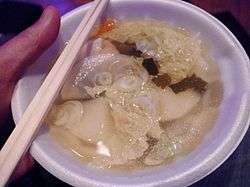
Ainu cuisine is the cuisine of the ethnic Ainu in Japan. The cuisine differs markedly from that of the majority Yamato people of Japan. Raw meat like sashimi, for example, is rarely served in Ainu cuisine, which instead uses methods such as boiling, roasting and curing to prepare meat. Also unlike Japanese cuisine, traditional Ainu cuisine did not use miso, soy sauce, or sugar, though these seasonings make an appearance in modern Ainu cuisine.[1] The island of Hokkaidō in northern Japan is where most Ainu live today; however, they once inhabited most of the Kuril islands, the southern half of Sakhalin island, and parts of northern Honshū Island.
There are very few Ainu restaurants in the world, though some do exist such as Ashiri Kotan Nakanoshima in Sapporo, and Poron'no and Marukibune in Ainu Kotan, Hokkaidō.
Overview
Traditional Ainu cuisine uses meats obtained through fishing and hunting such as salmon and deer, wild plants gathered in the mountains such as cardiocrinum cordatum bulbs (turep) and acorns, as well as various grains and potatoes obtained through farming. Other features include its liberal use of oils as flavoring.[2][3] Due to the Ainu's reliance on local game and fauna, not all areas used all the same ingredients, instead utilizing what was most available.[4]
In addition to salt, the fats (sum) from cod, sardines, herring, shark, seal, whale (humpesum), sika deer (yuksum), and bear (pasum) are used to flavor dishes.[5] Miso and soy sauce have also been used in modern times. Soup stocks may be made using kelp (kombu), animal bone, and dried fish. Seasoning and spices include pukusa (allium ochotense), berries from the Amur corktree (phellodendron amurense), and wavy bittercress (cardamine flexuosa).[6]
Ingredients
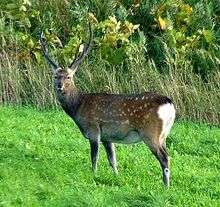


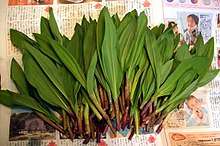
Game
The most predominate game animal was the sika deer.[7] Deer were hunted using poisoned arrows as well by herding them off cliffs and gathering them from where they fell.[8] In the past, deer were so common and easily hunted in Hokkaidō that it was said one could “put the pot on the fire, then go hunting”.[9]
- Brown bear (kimun kamuy)
- Chipmunk (ruop)
- Eurasian jay (parkew)
- Eurasian tree sparrow (amameciri)
- Ezo red fox (cironnup)
- Hazel Grouse (humiruy)
- Japanese marten (hoinu)
- Mallard (kopeca)
- Oriental turtle dove (kusuyep)
- Rabbit (isopo kamuy)
- Raccoon dog (moyuk)
- Sika deer (yuk)
Fish and Sea Creatures
The Ainu fished at sea in dugout canoes using harpoons to hunt a variety of large marine animals and used nets and fishing rods to bring in smaller creatures.[10] Beached whales were particularly prized, as generally it was impossible to bring a whale in using canoes and harpoons. However, there were some instances of whaling in Funka Bay using harpoons coated with wolfsbane poison, aided by the gentle tides. [11] The Ainu also used a number of tools including fishing rods, nets, traps (uray), and fishing baskets (raomap) to catch freshwater fish.[12]
- Bathyraja lindbergi (uttap)
- Capelin (susam)
- Cod (erekus)
- Crucian carp (rampara)
- Dolphin (tannup)
- Flounder (samampe)
- Fur seal (unew)
- Japanese dace (supun)
- Japanese fluvial sculpin (cimikani)
- Japanese huchen (ciray)
- Japanese smelt (tokikar)
- Masu salmon (icankot)
- Ocean sunfish (kinapo)
- Pacific herring (heroki)
- Pond loach (cicira)
- Salmon (kamuycep)
- Saffron cod (komay)
- Sardine (iwashi)
- Sea Lion (etaspe)
- Seal (tukar)
- Shark (same)
- Sturgeon (yupe)
- Swordfish (sirkap)
- Trout (icaniw)
- Whitespotted char (tuksis)
Gathered Plants
While men were responsible for hunting and fishing, women were responsible for gathering edible plants, which they began in early spring. Tools used during gathering trips into the mountains included the saranip (a bag woven from the fibers of the Japanese lime tree), the menoko makiri (a small women’s knife), itani (a type of digging stick), and the shitap (a small pick made from deer horn). [13] One of the most imporant mountain plants gathered in spring was the Siberian onion (pukusa), which is very similar to wild leeks found in Canada and the United States in taste, texture and appearance. Large quantities of cardiocrinum cordatum bulbs (turep) were gathered in summer as they were important as a preserved food.
Spring
- Anemone flaccida (ohaw kina or pukusakina)
- Angelica (cihue)
- Butterbur (makayo)
- Bracken (warumbi)
- Cow parsnip (pittok)
- Hog peanut (eha)
- Japanese butterbur (korkoni)
- Japanese mugwort (noya)
- Japanese spikenard (cimakina)
- Lance asiabell roots (topmuk)
- Long-stamen chive bulbs (mempiro)
- Maianthemum japonicum (pepero)
- Marsh-marigold roots (pui)
- Ostrich fern (sorma)
- Siberian onion (pukusa)
- Symplocarpus renifolius (sikerpe kina)
- Thistle (ancami)
Summer
- Cardiocrinum cordatum bulbs (turep)
Fall
- Amur cork tree berries (sikerpe)
- Crimson glory vine fruit (hat)
- Hardy kiwi fruit (kutci)
- Hen-of-the-woods mushroom (yuk karus)
- Japanese chestnuts (yam)
- Japanese emperor oak acorns (nisew)
- Japanese rose fruit (maw)
- Mushroom (karus)
- Oak acorns (pero)
- Walnuts (neshiko)
- Water caltrop fruit (pekampe)
Crops
Farming was already taking place in Hokkaidō during the Jōmon period, prior to the Satsumon period in which the Ainu first appeared. However, agriculture began to decline in the 12th century up until the Ainu period. Rather than being caused by the cold climate, it is thought to be caused by the increase in demand for dried fish and furs for trade with Honshū, leading to increased importance in hunting and fishing.[14] Cultivated crops changed over the years as new crops were introduced, such as potatoes, kabocha, and beans.[15]
- Bean varieties (mame)
- Buckwheat (soba)
- Foxtail millet (munchiro)
- Japanese millet (piyap)
- Potato (imo)
- Proso millet (menkul)
- Pumpkin (kabocha)
- Turnip (atane)
Primary Dishes
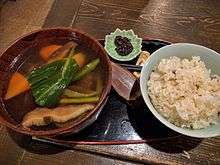
Citatap
Citatap translated from Ainu means “that which has been pounded”. As the name would suggest, citatep is meat or fish that has been pounded in a way similar to the Japanese method tataki.
Making Citatap[16]
- Salmon head, milt, and remains from filleting are placed on a cutting board-like round piece of wood sliced from a tree trunk (itatani). The meat is chopped and beaten with a sharp heavy object, such as a hatchet.
- The resulting paste is flavored with minced spring onion, pukusa, or long-stamen chive.
- Finally, the citatap is seasoned with dried kelp and salt.
Other than salmon, a variety of meats and fish are used to add flavor to citatap such as Japanese dace, bathyraja lindbergi, masu salmon, Japanese fluvial sculpin, deer, bear, tanuki, rabbit, and chipmunk. It was good to make citatap from the meat of older animals, as it made the tough meat easier to eat.[17] Citatap was primarily made in the winter, when food spoiled more slowly, and was eaten over a number of days. If the citatap was not particularly fresh, it was formed into balls and added to soup.[18]
Ohaw
Soup made from boiling fish or meats with various vegetables. Ohaw may be soup, or more like a Japanese nabemono (hot pot) that contains a high ratio of ingredients to broth. As a hunter-gatherer society, the Ainu did not have a staple food as such, but ohaw was a central dish in their food culture. It is thought to be the roots of Hokkaidō regional dishes such as Ishikari nabe and sanpei soup. There are no specific requirements for which ingredients to use for ohaw, but was generally made as described below.[19]
- A stock is created by heating animal bone or small dried fish in water.
- Roughly chopped meat or fish is added to the stock and cooked. Dried meat and fish require longer cooking times. The scum that results from cooking the meats is not removed, as it was thought to have medicinal properties.[20]
- Root vegetables or those which required longer cooking times are added, followed by high fiber mountain vegetables, and finally leafy vegetables. The soup is allowed to cook further until all ingredients are soft.
- The soup is flavored with animal or fish fats and a small amount of salt and topped with ground dried kelp or dried pukusa.
Different varieties of ohaw are named by their main ingredient such as cep ohaw (fish soup), kamuy ohaw (bear soup), kam ohaw (meat soup), and kina ohaw (vegetable soup). Anemone flaccida was particularly suited for use in soups and was therefore called ohaw kina, which literally translates as “soup grass”.
Rataskep
Translated literally, rataskep means “mixed food”. Wild vegetables and beans are stewed until soft and the liquid has evaporated, at which point the mixture is mashed and seasoned with bear or fish oils and a small amount of salt.[21] Rataskep was made as an everyday food, as well as for offerings at ceremonies, as it was considered a sacred food. There are unlimited varieties using different ingredients, below are a few examples.[21]
Sikerpe kina Rataskep
- Dried symplocarpus renifolius (sikerpe kina) is rehydrated in hot water, then boiled over low heat for hours until the water evaporates. It is cut into easy to eat pieces and seasoned with animal fat and salt.
Pukusa Rataskep
- Beans are boiled until soft, at which point Siberian onion (pukusa) stalks are added and cooked further, then seasoned with animal fat and salt.
Cihue Rataskep
- Made from angelica (cihue) gathered in early summer. Beans are boiled until soft, then angelica is added and further boiled. Finally, it is seasoned with animal and fish fats.
Kabocha Rataskep
- Beans are boiled until soft. Dried strips of pumpkin (kabocha) are rehydrated in water then boiled along with the beans. Once the pumpkin begins to break apart, the rataskep is seasoned with fish fats and salt and topped with berries from the Amur corktree (sikerpe).
Cipor Rataskep
- Also called cipor imo. Potatoes (imo) are boiled with skin on. Salmon roe (cipor) is placed in a separate pot and cooked over low heat until it starts to break down. The skin is removed from the cooked potatoes and they are sliced thickly before placing into the pot with the salmon roe. Salt is added and everything is mixed well.
Nisew Rataskep
- The hull is removed from acorns (nisew) which are then boiled and drained multiple times with the seed coat on to remove the bitter taste. They are then placed in water with beans and boiled together. The resulting broth is discarded. The water is replaced and the mixture is boiled further until soft, at which point corn flour is added. It is cooked to the desired consistency. Rice flour is added, the mixture is kneaded, and salt and animal fats are added for seasoning.
Sayo
A thin porridge made from boiling Japanese millet or rice. Generally, the grains are boiled alone, but occasionally gathered vegetables are added. Unlike other porridges in agricultural societies, sayo is not a staple food. Rather, Ainu would fill up on fatty soups and grilled meats then drink it like tea as a palate cleanser.[22] For that reason, sayo was made in a small dedicated pot so as to avoid mixing oils in from other dishes. Care was also taken to avoid mixing flavors when serving by using a separate ladle specifically for serving sayo (sayo kasup), rather than the usual ladle for serving soup (kasup).[23] As the porridge uses very little grains to make, a month’s supply for one person was approximately 1.8 liters. 108 liters would provide plenty for a family of five for a year.[24]
The following are examples of sayo varieties.[22]
Turep Sayo
- Sayo which contains on turep, the fermented remains from the process of making cardiocrinum cordatum (turep) starch. The hard dried on turep is first ground with mortar and pestle, then rehydrated in water. The sediment is removed from the water then formed into dumplings approximately three centimeters in diameter, and cooked in the sayo.
- Sayo which contains the cardiocrinum cordatum bulbs themselves is also called turep sayo.
Irup Sayo
- The starch from cardiocrinum cordatum bulbs is made into dumplings (sito) and placed in the sayo.
Ento Sayo
- Sayo which contains elsholtzia ciliata (ento), a mountain plant. This type of sayo was favored for its particular aroma.
Satsirari Sayo
- The lees (satsirari) left from the fermentation process of making rice wine (tonoto) is placed in sayo.
Kikinni Sayo
- Sayo which contains bark of the bird cherry tree (kikinni).
Cipor Sayo
- Salmon roe (cipor) is boiled along with the grain porridge. Raw salmon roe was only eaten in the fall as a delicacy. During other seasons, salted and dried roe (sat cipor) was used.
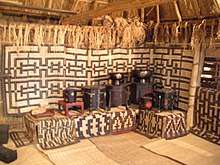
Sito
A type of dumplings. The name sito is derived from the Japanese shitogi which refers to dumplings or a paste made from grinding raw grains. [23][25] Traditionally, sito were considered a luxury due to the time and effort necessary to produce the flour by grinding the grains with mortar and pestle. It was therefore not a usual everyday food, but one made as offerings for sacred days such as the Bear Festival (iomante) and Ancestors’ Festival (icarup). [26]
Usual ingredients were proso millet (mankul), foxtail millet (munchiro), and rice (siamam), though sito made with proso millet were considered the correct form. Over the years, other ingredients were added such as pumpkin (kabocha), and potato (imo). Similar to the Japanese kusamochi, the Ainu also made sito which mixed in Japanese mugwort (noya). Their flavor was enjoyed as reminiscent of spring.[27]
Making Sito[28]
- Polished grains are left to soak overnight, then drained.
- The grains are placed in a large mortar and multiple people sing while pounding the grain with large pestles (iutaupopo).
- The resulting flour is kneaded with hot water and formed into round dumplings approximately 7 or 8 centimeters in diameter and 1 centimeter thick.
- The dumplings are boiled in a large pot, taking care not to allow them to burn on the bottom of the pot.
Sito that were meant to be offerings were placed as is in ceremonial lacquerware boxes (sintoko), wooden bowls (patci), on small trays (otcike), or skewered with cornus controversa sticks and presented to the gods.[29] When meant to be eaten by people, the sito were served with partially crushed salmon roe or a sauce made from mixing oils with dried and crushed kelp.[30]
Sito has a long history. Dumplings made from foxtail millet have been found in archeological Satsumon remains discovered in Atsuma.[31] Traditional Ainu cuisine did not use steamed rice to make dumplings, as the Japanese did with mochi. The Ainu first came in contact with Japanese style mochi after the Edo period when more ethnic Japanese moved to live in the same areas as the Ainu under the land contract system.[32]
Utensils and Eating Habits
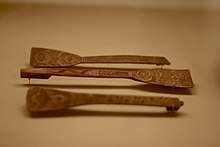
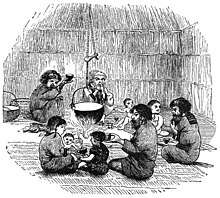
“Meal” in Ainu is “ipe”. Traditionally, two meals were eaten per day, breakfast (kunneywa ipe) and dinner (onuman ipe), and a third meal, lunch (tokes ipe), was added during the Taisho period. A night meal (kunne ipe) was sometimes eaten during night fishing or other late activities.[33]
Food was transferred from the cooking pot using a ladle (kasup) into a lacquerware bowl (itanki) for eating. These bowls were obtained through trade with the ethnic Japanese and were large enough to hold 400ml worth of food. Chunks of meat or fish that were too large to fit in the bowl were placed on mats woven from reeds.[23] Items such as fish roasted on a spit or sito were eaten by hand, but otherwise, most foods were eaten with chopsticks (pasuy) or spoons (parapasuy). Parapasuy translated literally means “wide chopstick”. Both spoons and chopsticks were carved from wood.[23]
When guests were over for food, the head woman of the house would offer food and say “ipeyan” (please eat). The guest would express their gratitude, and, if it were a valuable meal such as bear meat, they would raise the food to their forehead in thanks before beginning. However, the family would not say anything before eating if there were no guests. Once finished, it was customary to say “hunna” to express their gratitude for the food.[34]
Similar to the ethnic Japanese, it was considered polite to eat all food that was provided. Because of this, it was considered polite to use one’s finger to wipe the remaining sauce from inside the boil and lick it. This custom is the reason for the Ainu name for the pointer finger, “itanki kem atsukep”, literally meaning “bowl licking finger”.[23][31]
References
- ↑ イペ食べる (PDF). 北海道アイヌ民族文化研究センター. 2014. p. 30.
- ↑ アイヌ文化保存対策協議会 (1970). アイヌ民族誌. 第一法規出版. pp. 406–420. ASIN B000J9FZ8E.
- ↑ 国学院大学日本文化研究所 『日本の食とこころ - そのルーツと行方』 慶友社、2003年5月。 ISBN 4874492339
- ↑ イペ食べる (PDF). 北海道アイヌ民族文化研究センター. 2014. p. 4.
- ↑ 更科, 源蔵 (1968). アイヌ歴史と民俗. 社会思想社. p. 98. ASIN B000JA5YH0.
- ↑ 更科源蔵 『アイヌ伝説集』 みやま書房、1981年
- ↑ 岸上, 伸啓; 木原, 仁美; 葛野, 浩昭; 佐々木, 史郎; 手塚, 薫; 吉田, 睦 (1995). 世界の食文化20. 農山漁村文化協会. p. 93. ISBN 978-4540050060.
- ↑ アイヌ文化保存対策協議会 (1970). アイヌ民族誌. 第一法規出版. p. 337. ASIN B000J9FZ8E.
- ↑ 更科, 源蔵 (1968). アイヌ歴史と民俗. 社会思想社. p. 89. ASIN B000JA5YH0.
- ↑ 萩中, 美枝; 藤村, 久和; 村木, 美幸; 畑井, 朝子; 古原, 敏弘 (1992). Kikigaki Ainu no shokuji. Nō-san-gyoson Bunka Kyōkai. pp. 136–139. ISBN 9784540920042.
- ↑ アイヌ文化保存対策協議会 (1970). アイヌ民族誌. 第一法規出版. pp. 356–360. ASIN B000J9FZ8E.
- ↑ 萩中, 美枝; 藤村, 久和; 村木, 美幸; 畑井, 朝子; 古原, 敏弘 (1992). 聞き書き アイヌの食事. 農山漁村文化協会. pp. 136–139. ISBN 9784540920042.
- ↑ アイヌ文化保存対策協議会 (1970). アイヌ民族誌. 第一法規出版. pp. 367–374. ASIN B000J9FZ8E.
- ↑ 瀬川, 拓郎 (2007). アイヌの歴史. 講談社. p. 94. ISBN 978-4062584012.
- ↑ アイヌ民族博物館. "とる". アイヌ民族博物館. Retrieved 12 September 2018.
- ↑ 萩中, 美枝; 藤村, 久和; 村木, 美幸; 畑井, 朝子; 古原, 敏弘 (1992). 日本の食生活全集48 聞き書き アイヌの食事. 農山漁村文化協会. pp. 50–51. ISBN 9784540920042.
- ↑ 萩中, 美枝; 藤村, 久和; 村木, 美幸; 畑井, 朝子; 古原, 敏弘 (1992). 日本の食生活全集48 聞き書き アイヌの食事. 農山漁村文化協会. pp. 108–114. ISBN 9784540920042.
- ↑ 萩中, 美枝; 藤村, 久和; 村木, 美幸; 畑井, 朝子; 古原, 敏弘 (1992). 日本の食生活全集48 聞き書き アイヌの食事. 農山漁村文化協会. p. 109. ISBN 9784540920042.
- ↑ 萩中, 美枝; 藤村, 久和; 村木, 美幸; 畑井, 朝子; 古原, 敏弘 (1992). 日本の食生活全集48 聞き書き アイヌの食事. 農山漁村文化協会. pp. 35–37. ISBN 9784540920042.
- ↑ 萩中, 美枝; 藤村, 久和; 村木, 美幸; 畑井, 朝子; 古原, 敏弘 (1992). 日本の食生活全集48 聞き書き アイヌの食事. 農山漁村文化協会. p. 94. ISBN 9784540920042.
- 1 2 萩中, 美枝; 藤村, 久和; 村木, 美幸; 畑井, 朝子; 古原, 敏弘 (1992). 日本の食生活全集48 聞き書き アイヌの食事. 農山漁村文化協会. pp. 40–44. ISBN 9784540920042.
- 1 2 萩中, 美枝; 藤村, 久和; 村木, 美幸; 畑井, 朝子; 古原, 敏弘 (1992). 日本の食生活全集48 聞き書き アイヌの食事. 農山漁村文化協会. pp. 37–39. ISBN 9784540920042.
- 1 2 3 4 5 アイヌ文化保存対策協議会 (1970). アイヌ民族誌. 第一法規出版. pp. 406–420. ASIN B000J9FZ8E.
- ↑ 林喜, 茂 (1969). アイヌの農耕文化. 慶友社. p. 158. ASIN B000J9W90Q.
- ↑ 国学院大学日本文化研究所 (2003). 日本の食とこころ - そのルーツと行方. 慶友社. p. 150. ISBN 4874492339.
- ↑ 萩中, 美枝; 藤村, 久和; 村木, 美幸; 畑井, 朝子; 古原, 敏弘 (1992). 日本の食生活全集48 聞き書き アイヌの食事. 農山漁村文化協会. pp. 157–158. ISBN 9784540920042.
- ↑ アイヌ文化保存対策協議会 (1970). アイヌ民族誌. 第一法規出版. p. 378. ASIN B000J9FZ8E.
- ↑ 萩中, 美枝; 藤村, 久和; 村木, 美幸; 畑井, 朝子; 古原, 敏弘 (1992). 日本の食生活全集48 聞き書き アイヌの食事. 農山漁村文化協会. pp. 44–45. ISBN 9784540920042.
- ↑ 萩中, 美枝; 藤村, 久和; 村木, 美幸; 畑井, 朝子; 古原, 敏弘 (1992). 日本の食生活全集48 聞き書き アイヌの食事. 農山漁村文化協会. pp. 157–158. ISBN 9784540920042.
- ↑ 萩中, 美枝; 藤村, 久和; 村木, 美幸; 畑井, 朝子; 古原, 敏弘 (1992). 日本の食生活全集48 聞き書き アイヌの食事. 農山漁村文化協会. pp. 125–134. ISBN 9784540920042.
- 1 2 瀬川, 拓郎 (2007). アイヌの歴史. 講談社. p. 94. ISBN 978-4062584012.
- ↑ 林喜, 茂 (1969). アイヌの農耕文化. 慶友社. p. 171. ASIN B000J9W90Q.
- ↑ アイヌ文化保存対策協議会 (1970). アイヌ民族誌. 第一法規出版. p. 416. ASIN B000J9FZ8E.
- ↑ アイヌ文化保存対策協議会 (1970). アイヌ民族誌. 第一法規出版. p. 412. ASIN B000J9FZ8E.
Bibliography
- Kayano, Shigeru (萱野茂) (1996). 萱野茂のアイヌ語辞典 (Kayano Shigeru no ainu go jiten). Sanseidō.
- Batchelor, John (1905). Ainu-English-Japanese Dictionary: (including A Grammar of the Ainu Language. London: Methodist Publishing House.
- Batchelor, John; Miyabe, Kingo (1893), "Ainu economic plants", Transactions of the Asiatic Society of Japan, 221: 198–240
External links
| Wikimedia Commons has media related to Ainu food. |